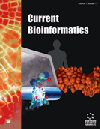- Home
- A-Z Publications
- Current Bioinformatics
- Previous Issues
- Volume 20, Issue 3, 2025
Current Bioinformatics - Volume 20, Issue 3, 2025
Volume 20, Issue 3, 2025
-
-
Comparative Analysis of Deep Generative Model for Industrial Enzyme Design
More LessAuthors: Beibei Zhang, Qiaozhen Meng, Chengwei Ai, Guihua Duan, Ercheng Wang and Fei GuoAlthough enzymes have the advantage of efficient catalysis, natural enzymes lack stability in industrial environments and do not even meet the required catalytic reactions. This prompted us to urgently de novo design new enzymes. As a powerful strategy, computational method can not only explore sequence space rapidly and efficiently, but also promote the design of new enzymes suitable for specific conditions and req Read More
-
-
-
Improved Hybrid Approach for Enhancing Protein-Coding Regions Identification in DNA Sequences
More LessIntroductionIdentifying and predicting protein-coding regions within DNA sequences play a pivotal role in genomic research. This paper introduces an approach for identifying protein-coding regions in DNA sequences by employing a hybrid methodology that combines digital bandpass filtering with wavelet transform and various spectral estimation techniques to enhance exon prediction. Specifically, the Haar and Daubechies w Read More
-
-
-
An Extended Feature Representation Technique for Predicting Sequenced-based Host-pathogen Protein-protein Interaction
More LessAuthors: Jerry Emmanuel, Itunuoluwa Isewon, Grace Olasehinde and Jelili OyeladeBackgroundThe use of machine learning models in sequence-based Protein-Protein Interaction prediction typically requires the conversion of amino acid sequences into feature vectors. From the literature, two approaches have been used to achieve this transformation. These are referred to as the Independent Protein Feature (IPF) and Merged Protein Feature (MPF) extraction methods. As observed, studies have predominantly Read More
-
-
-
Integrated Somatic Mutation Network Diffusion Model for Stratification of Breast Cancer into Different Metabolic Mutation Subtypes
More LessAuthors: Dongqing Su, Honghao Li, Tao Wang, Min Zou, Haodong Wei, Yuqiang Xiong, Hongmei Sun, Shiyuan Wang, Qilemuge Xi, Yongchun Zuo and Lei YangBackgroundMutations in metabolism-related genes in somatic cells potentially lead to disruption of metabolic pathways, which results in patients exhibiting different molecular and pathological features.ObjectiveIn this study, we focused on somatic mutation data to investigate the significance of metabolic mutation typing in guiding the prognosis and treatment of breast cancer patients.MethodsThe somatic mutation profile of b Read More
-
-
-
Validating the Distinctiveness of the Omicron Lineage within the SARS-CoV-2 based on Protein Language Models
More LessAuthors: Ke Dong and Jingyang GaoIntroductionVariants of concern were identified in severe acute respiratory syndrome coronavirus 2, namely Alpha, Beta, Gamma, Delta, and Omicron. This study explores the mutations of the Omicron lineage and its differences from other lineages through a protein language model.MethodsBy inputting the severe acute respiratory syndrome coronavirus 2 wild-type sequence into the protein language model e Read More
-
-
-
YADA - Reference Free Deconvolution of RNA Sequencing Data
More LessAuthors: Dani Livne, Tom Snir and Sol EfroniIntroductionWe present YADA, a cellular content deconvolution algorithm for estimating cell type proportions in heterogeneous cell mixtures based on gene expression data. YADA utilizes curated gene signatures of cell type-specific marker genes, either obtained intrinsically from pure cell type expression matrices or provided by the user.MethodsYADA implements an accessible and extensible deconvolution framework uniquely Read More
-
-
-
Enhancing Drug Peptide Sequence Prediction Using Multi-view Feature Fusion Learning
More LessAuthors: Junyu Zhang, Ronglin Lu, Hongmei Zhou and Xinbo JiangBackgroundCurrently, various types of peptides have broad implications for human health and disease. Some drug peptides play significant roles in sensory science, drug research, and cancer biology. The prediction and classification of peptide sequences are of significant importance to various industries. However, predicting peptide sequences through biological experiments is a time-consuming and expensive process. Moreove Read More
-
Volumes & issues
-
Volume 20 (2025)
-
Volume 19 (2024)
-
Volume 18 (2023)
-
Volume 17 (2022)
-
Volume 16 (2021)
-
Volume 15 (2020)
-
Volume 14 (2019)
-
Volume 13 (2018)
-
Volume 12 (2017)
-
Volume 11 (2016)
-
Volume 10 (2015)
-
Volume 9 (2014)
-
Volume 8 (2013)
-
Volume 7 (2012)
-
Volume 6 (2011)
-
Volume 5 (2010)
-
Volume 4 (2009)
-
Volume 3 (2008)
-
Volume 2 (2007)
-
Volume 1 (2006)
Most Read This Month
Article
content/journals/cbio
Journal
10
5
false
en


